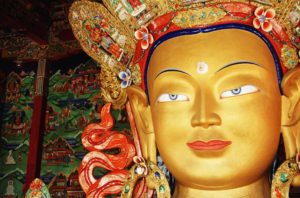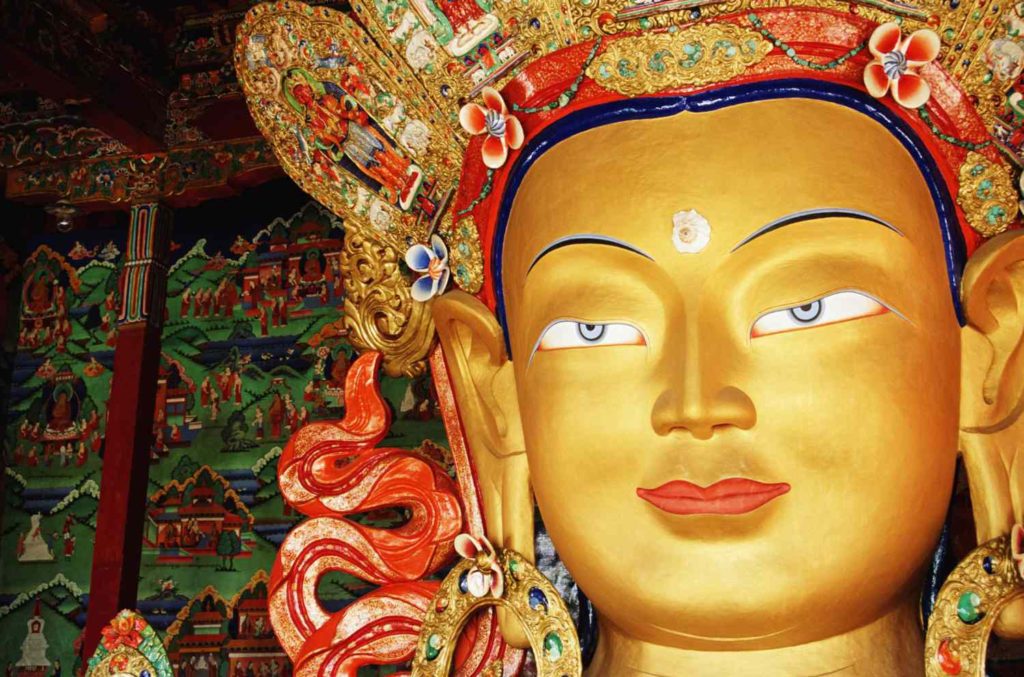#16 THE DIVINITY OF JESUS, ORIGINAL SIN, AND ARGUMENTS ABOUT BUDDHA NATURE

Maitreya Buddha
If you’ve read any books comparing the views of philosophers or theologians, what often stands out are their vehement disagreements on how to describe nuances of reality. Karen Armstrong’s great chronicle, A History of God: The 4,000-Year Quest of Judaism, Christianity and Islam (1993), assures us that who God is, how God is to be understood, comprises a 4,000 year argument on something you’d think was a centrally accepted paradigm.
To take a snippet, in the early 4th century C.E., a raging debate arose around the connection of God to His creation, particularly in the form of Jesus. God’s this great, spectacular, and permanent thing, and hence He must be separable from the mortal, earthly order. Hence, if you are to consider Jesus divine, Anathasius argued, Jesus could only come as God Himself, a piece of God’s identity, as it were—he or He certainly couldn’t be of the mortal flesh. Arius, on the other hand, held that Jesus was of this created order, distinctly separate from God, a mortal man who through the perfection of his life attained a divinity that God then granted Him. (It’s worth noting that Jesus liked to refer to himself as the “Son of Man.”)
From where I’m sitting, they both see mankind as lacking in divinity, but for Arius, mankind could redeem itself by its actions and be raised by God equal to the divine, while Anathasius saw nothing of the sort; Jesus could only come into this dirty world immaculately perfect from the get-go, bringing the Word, while everyone else had nothing to do with it.
As it happened, Anathasius won this debate, consigning Arius forever to the heretics’ dustbin, and severing the rest of mankind from Jesus in the general swath of succeeding Christian theology; Jesus was one thing, God Himself, the only one who could resolve the mess humanity had become, and humans would forever be something other than God/Jesus.
By the late 4th century, St. Augustine had come along, affirming the separation of humans from God, but seeing in humans the reflection or “trace” (as Armstrong puts it) of God, such that humans might re-find that in themselves, but “the immense distance between God and man cannot be traversed by human effort alone.” You could know God by contemplating his activities via Jesus, and that would restore His presence in your life.
Well, good. At least there was something you could do, despite being on the other side of the great divide.
As they certainly never taught me in Catholic school, it was Augustine (four full centuries after Christ!) who established the view of Original Sin, essentially blaming Eve, who tempted Adam into the Fall, for continuing to exist as the temptress present in all subsequent women, thus fucking it up for everyone ever since (thanks for that, Augie). “Misogyny” is a term that gets slung around at almost anything male that moves, but it’s an apt one here. Amazing, isn’t it, how this one guy’s sexual neurosis tainted his theology such that millions of people, male and female (and LGBTQetc.), to this day live with its stain.
But I digress from my theme.
The mahayana Buddhist tradition proclaimed in its “third turning” scriptures tathagatagarbha (Sanskrit: “buddha essence”), which has come generally into English as “buddha nature.” These sutras emphasized that sentient beings had the nature of a buddha, and on that basis, could attain the same enlightened wisdom as the Buddha.
While many western monotheists have fought to keep God and humanity separate, the Buddhist interest became how to identify the absolute and the relative together—though that definitely did not stop them from arguing about it. Like the issue of how to understand God, this topic alone stretches across millennia.
Here I’m using When the Clouds Part: The Uttaratantra and Its Meditative Tradition as a Bridge between Sutra and Tantra by Karl Brunnholzl (2014). (A note on Karl: How the hell does this guy do it? He seems to publish some thousand page tome of exhaustively researched commentary, quotation, summary, and finely translated classical texts on a yearly basis. This guy should be on the Mt. Rushmore of western Buddhist scholars by the time he’s finished.) I’ll gloss some threads.
Curiously, the Indian commentator you might associate most closely with buddha nature teachings, as he conveyed the scriptures of the Buddha Maitreya into print, the 4th century C.E. Yogachara master Asanga, only describes buddha nature as “suchness” (tathata), essentially meaning here the empty or selfless nature of reality. Maitreya’s Uttaratantra describes the wisdom qualities of buddha nature at great length –the omniscience, clairvoyance, fearless understanding, perfect compassion, unwavering skillfulness, and so on, a long list of miraculous and profound abilities–but all Asanga and other important Yogacharan commentators can find to say about it emphasizes its absence of concepts about reality.
Likely they were concerned about attacks from the Madhyamikan scholars, the other main branch of the mahayana, for asserting some kind of “existent” reality or self that all those wisdom qualities would constitute.
Chandrakirti (7th century Indian), a Madhyamikan master who had a great deal of influence on the Tibetans, regards buddha nature as a “nonimplicative negation,” i.e., it negates any concepts of self, that phenomena are empty of concept, but does not imply some further “existence,” objecthood, or self to emptiness. He finds the buddha nature teachings to be an “expedient” not definitive teaching; they exist to help beings trust that they can attain enlightenment, but really, there’s nothing there and there never has been, so don’t you dare make buddha nature into a thing.
It’s this kind of position, held by Chandrakirti, Haribhadra, and other Madhyamikans that held sway with the Tibetan Gelukpa lineage, which to this day still regards teachings on buddha nature as expedient, likely because its founder, Tsongkhapa (1357-1419) saw Chandrakirti as the end all and be all of ultimate truth.
That’s not the position of the 8th Karmapa, Mikyo Dorje (1507-1554) takes. Somewhat surprisingly, he freely criticizes Chandrakirti for his position that buddha nature is of expedient meaning, asserting instead that buddha nature is one’s “perfect nature,” the mind’s luminosity, that it’s the one thing that’s ultimately real, both permanent and able to express enlightened action. However, he insists that sentient beings don’t and can’t have buddha nature as they’re just a collection of delusions. Purify the delusions, and the sentient being is gone entirely, but the buddha nature itself becomes manifest.
Sakya Chogden (1428-1507) says that buddha nature as emptiness pervades all sentient beings, but this isn’t really the full on thing. In fact, you couldn’t possibly know it or manifest any sign of it until you’re a bodhisattva at the first stage (bhumi) of spiritual realization, with nine more to go. They begin to be in possession of the wisdom qualities of buddha nature, fully explicit at enlightenment. But until that first attainment…forget about it.
Dolpopa (1292-1361), the most ardent proclaimer of buddha nature in Tibet, saw it as fully articulated as the 64 wisdom qualities of a completely realized buddha inherent in all sentient beings (albeit hidden)–fully existent, permanent, unchanging, beyond all attempts at negation. All phenomena are empty of conceptual constructs, but ultimate reality is buddha nature in all its luminous splendor, something always present and never apart from sentient beings, the one real and true thing. He vigorously argues, however, that the delusions of sentient consciousness are to one side completely without reality, and buddha nature is wholly on the other—the only true reality.
The 3rd Karmapa, Rangjung Dorje (1284-1339), much like Dolpopa, sees buddha nature as ultimate, luminous, nondual wisdom, but since he sees this as the basis of both relative samsara and absolute nirvana, he asserts that samsaric ignorance is not recognizing buddha nature as the only reality, while recognizing it is liberation. Dolpopa would vehemently disagree, since the perfect wisdom of buddha nature can’t, in his view, be the basis of confusion.
Well, I’ll stop there. There are plenty more permutations. In western monotheism, there’s a driving need to see God as perfect and flawless, and equal conviction that we live in a fallen, stained world (even though God created it, but anyway…), so how do you both separate them out but keep them in some kind of communication?
The Buddhist concern is mostly how to keep emptiness from becoming a thing, and yet you end up with a rather big philosophical problem that emptiness is also the nature of buddha, and doesn’t a buddha, as it states in the buddha nature scriptures, overflow with limitless virtues and excellent qualities? Are those described as a convenient expediency, but we don’t really mean it? How can sentient beings possess buddha nature when they’re nothing more than delusional projections? Is this perfection not at all knowable until you’re enlightened anyway? Is it something you gradually uncover, if you get into it far enough? Is this the only real thing? Does this “only real thing” constitute both what we turn into confusion or into all those glorious, enlightened characteristics?
Of course, you can choose whom you prefer to believe, but consider: all these folks (on the Buddhist side) are regarded as fully enlightened themselves, so…are we to conclude that once you’re enlightened, you’re still too human to resist a good argument? Or are we just up against the usual abyss that opens up between paragraphs, sentences, words? You can spend a thousand years arguing about it with the greatest, most informed minds, and still the actuality slips through everyone’s grip.


I really enjoyed this global contemplation of relative and ultimate in theistic and non-theistic traditions! So well thought out and written. Thanks!
Dan